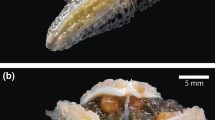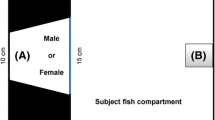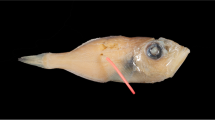Abstract
The reproductive biology of deep-sea fishes is largely unknown because of the difficulty of behavioral observations in this environment. In this study, the reproductive behavior of the deep-sea snailfish, Careproctus pellucidus, which lives at depths > 200 m, was observed in an aquarium. Fishes were collected at a depth of approximately 300 m in the North Pacific Ocean (36°70′N; 141°00′E) in July and August 2018 and kept for observation until March 2019. We observed that spawning events usually took place between one male and one female. Males defended a spawning substrate against other males and exhibited body-wiggling behavior for both courtship and aggressive display. Females visited the male’s territory and spawned a demersal adhesive egg mass on the substrate. The territorial male then sought the spawned eggs using the filamentous rays in the lower pectoral-fin lobe and released sperm when he located the eggs. Males remained near the spawning substrate after spawning but did not perform any parental care. Notably, sneaking behavior by a non-territorial male was observed in one case; this is the first report of this alternative reproductive strategy (or tactic) in a deep-sea fish. Our study reveals the spawning of C. pellucidus appear to use the mechanosensory lateral line and the chemical sense heavily to adapt to the dim sunlight deep-sea environment.







Similar content being viewed by others
Availability of data and materials
The data sets generated during and/or analyzed during the current study are available from the corresponding author, TM, on reasonable request.
Code availability
Not applicable.
References
Able KW, Musick JA (1976) Life history, ecology, and behavior of Liparis inquilinus (Pisces Cyclopteridae) associated with sea scallop, Placopecten magellanicus. Fish Bull 74:409–421
Brantley RK, Bass AH (1994) Alternative male spawning tactics and acoustic signals in the plainfin midshipman fish Porichthys notatus Girard (Teleostei, Batrachoididae). Ethology 96:213–232. https://doi.org/10.1111/j.1439-0310.1994.tb01011.x
Branconi R, Barbasch TA, Francis RK, Srinivasan M, Jones GP, Buston PM (2020) Ecological and social constraints combine to promote evolution of non-breeding strategies in clownfish. Commun Biol 3:649. https://doi.org/10.1038/s42003-020-01380-8
Busby MS, Orr JW, Blood DM (2006) Eggs and late-stage embryos of Allocareproctus unangas (family Liparidae) from the Aleutian Islands. Ichthyol Res 53:423–426. https://doi.org/10.1007/s10228-006-0361-3
Butler JM, Maruska KP (2015) The mechanosensory lateral line is used to assess opponents and mediate aggressive behaviors during territorial interactions in an African cichlid fish. J Exp Biol 218:3284–3294. https://doi.org/10.1242/jeb.125948
Butler JM, Maruska KP (2016) Mechanosensory signaling as a potential mode of communication during social interactions in fishes. J Exp Biol 219:2781–2789. https://doi.org/10.1242/jeb.133801
Chernova NV (1987) Aquarium observations of the snailfishes Careproctus reinhardti and Liparis liparis. Tr Zool Inst Acad Nauk SSSR 162:95–99
Chernova NV (2005) New Species of Careproctus Liparidae from the Barents Sea and Adjacent Waters. J Ichthyol 45:689–699
Chernova NV (2014a) New species of the genus Careproctus (Liparidae) from the Kara Sea with notes on spongiophilia, reproductive commensalism between fishes and sponges (Rossellidae). J Ichthyol 54:501–512. https://doi.org/10.1134/S0032945214050038
Chernova NV (2014b) New species of the genus Careproctus (Liparidae) from the Kara Sea and identification key for congeners of the North Atlantic and Arctic. J Ichthyol 54:757–780. https://doi.org/10.1134/S003294521410004X
Chernova NV, Stein DL, Andriashev AP (2004) Family Liparidae Scopoli 1777—snailfishes. Calif Acad Sci Annot Checkl Fishes 31:1–72
Cohen J (1988) Statistical power analysis for the behavioral sciences, 2nd edn. Lawrence Erlbaum Assoc, New Jersey
Davis MP, Fielitz C (2010) Estimating divergence times of lizardfishes and their allies (Euteleostei: Aulopiformes) and the timing of deep-sea adaptations. Mol Phylogenet Evol 57:1194–1208. https://doi.org/10.1016/j.ympev.2010.09.003
DeMartini EE (1978) Apparent paternal care in Liparis fucensis (Pisces: Cyclopteridae). Copeia 1978:537–539. https://doi.org/10.2307/1443625
Detwyler R (1963) Some aspects of the biology of the seasnail, Liparis atlanticus (Jordan and Evermann). University of New Hampshire, US, p 103
Enquist M, Leimar O, Ljungberg T, Mallner Y, Segerdahl N (1990) A test of the sequential assessment game: fighting in the cichlid fish Nannacara anomala. Anim Behav 40:1–14. https://doi.org/10.1016/S0003-3472(05)80660-8
Ferry-Graham LA, Drazen JC, Franklin V (2007) Laboratory observations of reproduction in the Deep-Water Zoarcids Lycodes cortezianus and Lycodapus mandibularis (Teleostei: Zoarcidae). Pac Sci 61:129–139. https://doi.org/10.1353/psc.2007.0004
Fricke R, Eschmeyer WN, Fong JD (2021) Eschmeyer's catalog of fishes: genera/species by family/subfamily. California Academy of Sciences. http://researcharchive.calacademy.org/research/ichthyology/catalog/SpeciesByFamily.asp. Accessed 16 February 2021
Fujii T, Jamieson AJ, Solan M, Bagley PM, Priede IG (2010) A large aggregation of liparids at 7703 meters and a reappraisal of the abundance and diversity of hadal fish. Bioscience 60:506–515. https://doi.org/10.1525/bio.2010.60.7.6
Gardner JR, Orr JW, Stevenson DE, Spies I, Somerton DA (2016) Reproductive parasitism between distant phyla: molecular identification of snailfish (Liparidae) egg masses in the gill cavities of king crabs (Lithodidae). Copeia 104:645–657. https://doi.org/10.1643/CI-15-374
Ghiselin MT (1969) The evolution of hermaphroditism among animals. Q Rev Biol 44:189–208. https://doi.org/10.1086/406066
Gilbert CH, Burke CV (1912) New cyclogasterid fishes from Japan. Proc US Nat Mus 42:351–380
Gonçalves EJ, Almada VC, Oliveira RF, Santos AJ (1996) Female mimicry as a mating tactic in males of the blenniid fish Salaria pavo. J Mar Biol Assoc U K 76:529–538. https://doi.org/10.1017/S0025315400030721
Hayakawa Y, Munehara H (1996) Non-copulatory spawning and female participation during early egg care in a marine sculpin Hemilepidotus gilberti. Ichthyol Res 43:73–78
JAMSTEC (Japan Agency for Marine Earth Science and Technology) (2017) Deepest fish ever recorded–documented at depths of 8,178 m in Mariana Trench. Japan Agency for Marine Earth Science and Technology Press Releases. https://www.jamstec.go.jp/e/about/press_release/20170824/. Accessed 16 February 2021
Johnson A, Hamilton TJ (2017) Modafinil decreases anxiety-like behaviour in zebrafish. Peer J 5:e2994. https://doi.org/10.7717/peerj.2994
Kai Y, Matsuzaki K (2019) Careproctus longidigitus, a new snailfish (Liparidae) from the southern Sea of Okhotsk. Ichthyol Res 67:133–138. https://doi.org/10.1007/s10228-019-00711-y
Kai Y, Matsuzaki K, Orr JW, Mori T, Kamiunten M (2021) A new species of Elassodiscus (Cottoidei: Liparidae) from the North Pacific with an emended diagnosis of the genus. Ichthyol Res 68:55–66
Kido K (1988) Phylogeny of the family Liparididae, with the taxonomy of the species found around Japan. Mem Fac Fish Hokkaido Univ 35:125–256
Kierl NC, Johnston CE (2010) Sound production in the pygmy sculpin Cottus paulus (Cottidae) during courtship and agonistic behaviours. J Fish Biol 77:1268–1281. https://doi.org/10.1111/j.1095-8649.2010.02745.x
Kuwamura T (1985) Social and reproductive behavior of three mouthbrooding cardinalfishes, Apogon doederleini, A. niger and A. notatus. Environ Biol Fishes 13:17–24. https://doi.org/10.1007/BF00004852
Linley TD, Gerringer ME, Yancey PH, Drazen JC, Weinstock CL, Jamieson AJ (2016) Fishes of the hadal zone including new species, in situ observations and depth records of Liparidae. Deep Sea Res I Oceanogr Res Pap 114:99–110. https://doi.org/10.1016/j.dsr.2016.05.003
Lloyd JE (1965) Aggressive mimicry in Photuris: firefly femmes fatales. Science 149:653–654. https://doi.org/10.1126/science.149.3684.653
Lloyd JE (1975) Aggressive mimicry in Photuris fireflies: signal repertoires by femmes fatales. Science 187:452–453. https://doi.org/10.1126/science.187.4175.452
Marchesan M, Ota D, Ferrero EA (2000) The role of mechanical stimulation during breeding in the grass goby Zosterisessor ophiocephalus (Teleostei, Gobiidae). Ital J Zool 67:25–30. https://doi.org/10.1080/11250000009356290
Marshall NB (1967) The Olfactory Organs of Bathypelagic Fishes. Symp Zool Soc London 19:57–70
Matsuzaki K, Mori T, Kamiunten M, Yanagimoto T, Kai Y (2020) A new species of Careproctus (Cottoidei: Liparidae) from the Sea of Okhotsk and a redescription of the blacktip snailfish Careproctus zachirus. Ichthyol Res 67:399–407. https://doi.org/10.1007/s10228-020-00734-w
Medina LM, Garcia CM, Urbina AF, Manjarrez J, Moyaho A (2013) Female vibration discourages male courtship behaviour in the Amarillo fish (Girardinichthys multiradiatus). Behav Processes 100:163–168. https://doi.org/10.1016/j.beproc.2013.09.007
Munk O (1965) Ocular degeneration in deep-sea fishes. Galathea Rep 8:21–31
Nakazawa K (1915) On a fish which spawns in the gill cavity of a king crab, Paralithodes camtschaticus (in Japanese). Dobuts Zasshi 27:164–165
Nelson JS, Grande TC, Wilson MV (2016) Fishes of the World, 5th edn. Wiley, US
Orr JW (2012) Two new species of snailfishes of the genus Careproctus (Scorpaeniformes: Liparidae) from the Bering Sea and eastern North Pacific Ocean, with a redescription of Careproctus ovigerus. Copeia 2012:257–265. https://doi.org/10.1643/CI-11-046
Orr JW (2016) Two new species of snailfishes of the genus Careproctus (Liparidae) from the Aleutian Islands, Alaska. Copeia 104:890–896. https://doi.org/10.1643/CI-15-378
Orr JW, Kai Y, Nakabo T (2015) Snailfishes of the Careproctus rastrinus complex (Liparidae): redescriptions of seven species in the North Pacific Ocean region, with the description of a new species from the Beaufort Sea. Zootaxa 4018:301–348. https://doi.org/10.11646/zootaxa.4018.3.1
Orr JW, Spies I, Stevenson DE, Longo GC, Kai Y, Ghodes S, Hollowed M (2019) Molecular phylogenetics of snailfishes (Liparidae: Cottoidei) based on mtDNA and RADseq genomic analyses, with comments on selected morphological characters. Zootaxa 4642:1–79. https://doi.org/10.11646/zootaxa.4642.1.1
Orr JW, Pitruk DL, Manning R, Stevenson DE, Gardner JR, Spies I (2020) A new species of snailfish (Cottiformes: Liparidae) closely related to Careproctus melanurus of the eastern North Pacific. Copeia 108:711–726. https://doi.org/10.1643/CI2020008
Ota K, Kohda M (2006) Description of alternative male reproductive tactics in a shell-brooding cichlid, Telmatochromis vittatus, in Lake Tanganyika. J Ethol 24:9–15. https://doi.org/10.1007/s10164-005-0154-6
Overdick AA, Busby MS, Blood DM (2014) Descriptions of eggs of snailfishes (family Liparidae) from the Bering Sea and eastern North Pacific Ocean. Ichthyol Res 61:131–141. https://doi.org/10.1007/s10228-013-0384-5
Pietsch TW (2005) Dimorphism, parasitism, and sex revisited: modes of reproduction among deep-sea ceratioid anglerfishes (Teleostei: Lophiiformes). Ichthyol Res 52:207–236. https://doi.org/10.1007/s10228-005-0286-2
Pietsch TW (2009) Oceanic anglerfishes: extraordinary diversity in the deep sea. University of California Press, Berkeley, CA
Pietsch TW, Orr JW (2007) Phylogenetic relationships of deep-sea anglerfishes of the suborder Ceratioidei (Teleostei: Lophiiformes) based on morphology. Copeia 2007:1–34. https://doi.org/10.1643/0045-8511(2007)7[1:PRODAO]2.0.CO;2
Poltev YN, Mukhametov IN (2009) Concerning the problem of carcinophilia of Careproctus species (Scorpaeniformes: Liparidae) in the North Kurils. Russ J Mar Biol 35:215–223. https://doi.org/10.1134/S1063074009030043
Priede IG, Drazen JC, Bailey DM, Kuhnz LA, Fabian D (2020) Abyssal demersal fishes recorded at station M (34°50′N, 123°00′W, 4100 m depth) in the northeast Pacific Ocean: An annotated check list and synthesis. Deep Sea Res II Top Stud Oceanogr 173:104648. https://doi.org/10.1016/j.dsr2.2019.104648
R Core Team (2020) R: A Language and Environment for Statistical Computing. R Foundation for Statistical Computing, Vienna, Austria. https://www.R-project.org/. Accessed 26 February 2021
Rosenthal R (1994) Parametric measures of effect size. In: Cooper H, Hedges LV (eds) The Handbook of Research Synthesis, 1st edn. Russell Sage Foundation, New York, p 589
Sakurai Y, Kido K (1992) Feeding behavior of Careproctus rastrinus (Liparididae) in captivity. Jap J Ichthyol 39:110–113. https://doi.org/10.11369/jji1950.39.110
Satou M, Takeuchi HA, Takei K, Hasegawa T, Matsushima T, Okumoto N (1994a) Characterization of vibrational and visual signals which elicit spawning behavior in the male himé salmon (landlocked red salmon, Oncorhynchus nerka). J Comp Physiol A 174:527–537. https://doi.org/10.1007/BF00217372
Satou M, Takeuchi HA, Nishii J, Tanabe M, Kitamura S, Okumoto N, Iwata M (1994b) Behavioral and electrophysiological evidences that the lateral line is involved in the inter-sexual vibrational communication of the himé salmon (landlocked red salmon, Oncorhynchus nerka). J Comp Physiol A 174:539–549. https://doi.org/10.1007/BF00217373
Science (2018) Exclusive: ‘I’ve never seen anything like it.’ Video of mating deep-sea anglerfish stuns biologists. https://www.sciencemag.org/news/2018/03/exclusive-i-ve-never-seen-anything-it-video-mating-deep-sea-anglerfish-stuns-biologists. Accessed 26 February 2021
Sneddon LU, Braithwaite VA, Gentle MJ (2003) Novel object test: examining nociception and fear in the rainbow trout. J Pain 4:431–440. https://doi.org/10.1067/S1526-5900(03)00717-X
Somerton DA, Donaldson W (1998) Parasitism of the golden king crab, Lithodes aequispinus, by two species of snailfish, genus Careproctus. Fish Bull 96:871–884
Stein DL (2012) Snailfishes (family Liparidae) of the Ross Sea, Antarctica, and closely adjacent waters. Zootaxa 3285:1–120. https://doi.org/10.11646/zootaxa.3285.1.1
Stoltz JA, Neff BD (2006) Male size and mating tactic influence proximity to females during sperm competition in bluegill sunfish. Behav Ecol Sociobiol 59:811–818. https://doi.org/10.1007/s00265-005-0127-3
Taborsky M (1994) Sneakers, satellites, and helpers: parasitic and cooperative behavior in fish reproduction. Adv Study Behav 23:1–100
Taborsky M (2008) Alternative reproductive tactics in fish. In: Oliveira RF, Taborsky M, Brockmann HJ (eds) Alternative reproductive tactics: an integrative approach. Cambridge University Press, Cambridge, pp 251–299
Taru M, Kanda T, Sunobe T (2002) Alternative mating tactics of the gobiid fish Bathygobius fuscus. J Ethol 20:9–12. https://doi.org/10.1007/s10164-002-0047-x
Tsuruwaka Y, Shimada E (2011) Rearing and spawning of the deep-sea fish Malacocottus gibber in the laboratory. Ichthyol Res 58:188–190. https://doi.org/10.1007/s10228-010-0200-4
Warner RR (1984) Mating behavior and hermaphroditism in coral reef fishes. Am Sci 72:128–136
Warner RR, Lejeune P (1985) Sex change limited by paternal care: a test using four Mediterranean labrid fishes, genus Symphodus. Mar Biol 87:89–99. https://doi.org/10.1007/BF00397010
Warner RR, Robertson DR (1978) Sexual patterns in the labroid fishes of the western Caribbean I: the wrasses. Smithson Contrib Zool 254:1–27
Yau C, Collins MA, Everson I (2000) Commensalism between a liparid fish (Careproctus sp.) and stone crabs (Lithodidae) photographed in situ using a baited camera. J Mar Biol Ass UK 80:379–380. https://doi.org/10.1017/S0025315499002052
Yashiki H, Takami S, Spahn F, Sakuma K, Itoh H, Hamatsu T, Narimatsu Y, Yanagimoto T, Kojima S (2020) Inbreeding Between Deep-sea Snailfishes Careproctus pellucidus and Careproctus rastrinus in the Northwestern Pacific Ocean. Zoolog Sci 37:323–330. https://doi.org/10.2108/zs200011
Acknowledgements
We are grateful to Takashi Suzuki, J. Suzuki, Takayasu Suzuki, S. Suzuki, and S. Katayose for collection of live fishes. Our appreciation is also extended to Y. Abe (Executive Director, Aquamarine Fukushima) and A. Komoda (General Curator Aquamarine Fukushima) for their valuable advice and discussion, and M. Kuraishi, K. Matsuzaki, M. Kamiunten, and R. Murai (Aquarium Staff) for their assistance during the study. T. Iwasaki (Fukushima Prefectural Fisheries and Marine Science Research Centre) provided us with valuable data. Y. Kai (Kyoto University) led to significant improvement of the manuscript. We sincerely thank S. Awata (Osaka-City University), and H. Kohtsuka (The University of Tokyo) for their valuable advice. Critical reading by two anonymous reviewers significantly improved the manuscript.
Funding
This study was funded by the Marine Science Museum Fukushima.
Author information
Authors and Affiliations
Contributions
TM: Conceptualization, methodology, validation, investigation, writing—original draft, visualization. KF: Conceptualization, methodology, formal analysis, writing—original draft, writing—review and editing, visualization. SO: Investigation. SY: Conceptualization, methodology, resources. TY: Conceptualization, supervision.
Corresponding author
Ethics declarations
Conflict of interest
The authors have no conflict of and competing interests.
Ethics approval
The facility where we had conducted all animal experiments has no stated ethical guidelines for teleost fishes. Therefore, we carried out all experiments in compliance with the ABS/ASAB guidelines for the ethical treatment of animals. Research permission was obtained from Fisheries Cooperative Association of Ibaraki, Japan.
Consent to participate
Not applicable.
Consent for publication
Not applicable.
Additional information
Responsible Editor: D. Goulet.
Publisher's Note
Springer Nature remains neutral with regard to jurisdictional claims in published maps and institutional affiliations.
Supplementary Information
Below is the link to the electronic supplementary material.
Male–male competition between territorial male (T-male) and non-territorial male (NT-male)
Courtship behavior by a territorial male (T-male)
Spawning by female and seeking eggs followed by releasing sperm by a territorial male (T-male)
Sneaking behavior by non-territorial male (sneaker); T-male territorial male
Rights and permissions
About this article
Cite this article
Mori, T., Fukuda, K., Ohtsuka, S. et al. Reproductive behavior and alternative reproductive strategy in the deep-sea snailfish, Careproctus pellucidus. Mar Biol 169, 42 (2022). https://doi.org/10.1007/s00227-022-04028-9
Received:
Accepted:
Published:
DOI: https://doi.org/10.1007/s00227-022-04028-9




